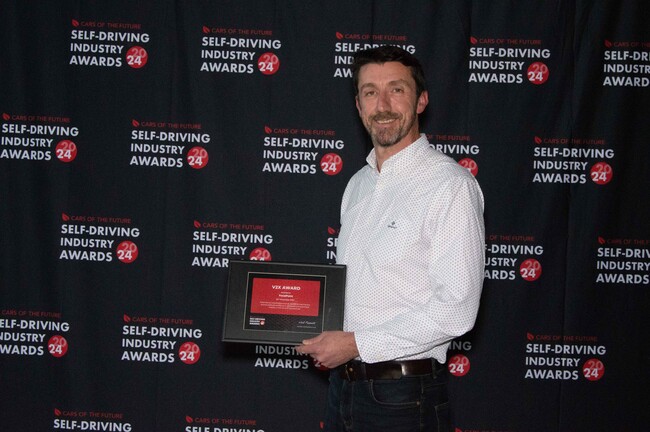V2X for safety: Vehicle-to-everything technology for emergency vehicle management in smart cities
Ramya Sriram
5 min read
17th Feb, 2025

We’re well on the way towards living in a world of smart cities, where connectivity and technology converge to enhance urban living. With this enhancement comes one of the most promising innovations: Vehicle-to-Everything (V2X) communication. V2X will eventually allow vehicles to communicate with each other, traffic infrastructure, and even pedestrians in real time.
One of the most impactful applications of V2X in a smart city is its role in improving emergency vehicle management, enabling faster response times, and increasing safety for both first responders and the public. In this blog article, we will explore how V2X technology can be used to prioritise emergency vehicles, and why the current city-scape is not yet ready to provide safer routes for those in urgent need.
What is V2X?
V2X technology is the grouped term for a variety of communication systems, including Vehicle-to-Vehicle (V2V), Vehicle-to-Infrastructure (V2I), and Vehicle-to-Pedestrian (V2P). At its core, V2X enables the exchange of information between vehicles and other elements of the urban environment, such as traffic lights, road signs, and even cloud-based platforms. This real-time exchange helps vehicles make smarter decisions, anticipate hazards, and respond to changing traffic conditions more effectively.
In the context of emergency vehicles, V2X communication can adjust traffic systems and provide real-time alerts to both drivers and infrastructure to ensure that first responders can reach their destinations quickly and safely.
In 2024, the first European deployment of V2X alerting in firefighting took place in the UK, with Avon Fire & Rescue Service using HAAS Alert’s digital alerting system. This is an important, but early step in the use of V2X, sending out notifications to nearby drivers through Waze and other leading navigation apps.
Types of V2X Technology
Two primary technologies, Cellular V2X (C-V2X) and Dedicated Short-Range Communications (DSRC), offer different approaches to enabling V2X connectivity. While C-V2X leverages cellular networks, DSRC operates on a dedicated spectrum for direct communication. To bridge compatibility gaps, automotive manufacturers are also developing hybrid V2X solutions that integrate both technologies, ensuring seamless communication across varying infrastructure and regulatory landscapes.
C-V2X, currently being offered by chipset manufacturers like Qualcomm, uses cellular networks like LTE-V2X (4G) and evolving 5G NR-V2X to enable connected vehicles. A dedicated DSRC approach uses Wi-Fi-based communication exclusively for V2X connectivity. DSRC operates on a reserved spectrum and provides low-latency, short-range direct communication without needing a cellular network. A good example is the NXP RoadLINK SAF5400 chipset, a dedicated DSRC V2X solution for V2V and V2I communication.
Automotive manufacturers like Continental offer a hybrid V2X system that combines C-V2X and DSRC to ensure seamless connectivity across different regions and infrastructure standards. Continental’s V2X Hybrid Communication Platform integrates both C-V2X and DSRC to maximise compatibility and coverage.
Emergency Vehicles and the Challenge of Traffic Congestion
When an emergency vehicle needs to get through traffic, every second counts. However, in many urban environments, heavy traffic congestion can severely delay emergency responders, especially in cities where the roads are narrow, junctions are congested, and drivers are often too distracted to efficiently react to emergency vehicles.
To mitigate these delays, V2X technology could be integrated into emergency vehicle management systems to prioritise emergency vehicles in traffic. This integration would not only reduce response times but also increase public safety by minimising the risk of accidents and traffic-related issues that can arise during these high-pressure situations.
How V2X Technology Optimises Emergency Vehicle Response
Priority alerts to drivers
Emergency vehicles can send alerts to surrounding vehicles, informing drivers of their approach. These alerts can be transmitted through in-vehicle systems, such as advanced driver-assistance systems (ADAS), that warn drivers to move over, slow down, or clear the way. This system eliminates the need for drivers to rely on auditory cues like sirens, making it possible to respond to an emergency vehicle’s approach even in noisy or crowded environments.
For instance, when an ambulance is approaching an intersection, V2X alerts can be sent to nearby vehicles, instructing them to safely change lanes or pull over, ensuring the emergency vehicle has a clear path. In high-traffic situations, these alerts can also extend to autonomous vehicles, which are capable of following pre-programmed protocols to clear the way for emergency responders.
Dynamic traffic signal control
Traditional traffic lights follow preset timing patterns that don’t account for real-time traffic conditions or emergency needs. V2X technology can connect emergency vehicles to traffic signal systems, allowing the signals to dynamically adjust in favor of the emergency responders.
When an emergency vehicle approaches an intersection, V2X communication can trigger traffic signals to change in real time—turning them green in the direction of the approaching emergency vehicle and red for all other vehicles. This “green wave” would enable the emergency vehicle to pass through intersections without delay, significantly reducing response times. Furthermore, V2X-enabled traffic systems can extend green lights for a longer duration if necessary, allowing emergency vehicles to traverse multiple intersections without stopping.
Route optimisation
V2X can also help emergency vehicles optimise their routes in real-time by providing updated information on road conditions, traffic congestion, accidents, or construction. This allows emergency responders to avoid bottlenecks, roadblocks, or other delays, helping them reach their destinations more quickly. By integrating V2X with GPS and mapping systems, smart city infrastructure can provide first responders with the fastest and safest route available, even when unexpected obstacles arise.
Real-time communication with traffic management centres
V2X technology can also enable direct communication between emergency vehicles and city traffic management centers. This communication ensures that traffic managers are aware of the ongoing emergency response and can take additional steps to manage traffic flow accordingly. For example, they might reroute traffic, issue advisories to drivers, or deploy additional traffic controllers to help clear the path for emergency vehicles. This collaboration between vehicles, infrastructure, and traffic managers improves situational awareness and decision-making.
Priority alerts to drivers
Emergency vehicles can send alerts to surrounding vehicles, informing drivers of their approach. These alerts can be transmitted through in-vehicle systems, such as advanced driver-assistance systems (ADAS), that warn drivers to move over, slow down, or clear the way. This system eliminates the need for drivers to rely on auditory cues like sirens, making it possible to respond to an emergency vehicle’s approach even in noisy or crowded environments.
For instance, when an ambulance is approaching an intersection, V2X alerts can be sent to nearby vehicles, instructing them to safely change lanes or pull over, ensuring the emergency vehicle has a clear path. In high-traffic situations, these alerts can also extend to autonomous vehicles, which are capable of following pre-programmed protocols to clear the way for emergency responders.
Dynamic traffic signal control
Traditional traffic lights follow preset timing patterns that don’t account for real-time traffic conditions or emergency needs. V2X technology can connect emergency vehicles to traffic signal systems, allowing the signals to dynamically adjust in favor of the emergency responders.
When an emergency vehicle approaches an intersection, V2X communication can trigger traffic signals to change in real time—turning them green in the direction of the approaching emergency vehicle and red for all other vehicles. This “green wave” would enable the emergency vehicle to pass through intersections without delay, significantly reducing response times. Furthermore, V2X-enabled traffic systems can extend green lights for a longer duration if necessary, allowing emergency vehicles to traverse multiple intersections without stopping.
Route optimisation
V2X can also help emergency vehicles optimise their routes in real-time by providing updated information on road conditions, traffic congestion, accidents, or construction. This allows emergency responders to avoid bottlenecks, roadblocks, or other delays, helping them reach their destinations more quickly. By integrating V2X with GPS and mapping systems, smart city infrastructure can provide first responders with the fastest and safest route available, even when unexpected obstacles arise.
Real-time communication with traffic management centres
V2X technology can also enable direct communication between emergency vehicles and city traffic management centers. This communication ensures that traffic managers are aware of the ongoing emergency response and can take additional steps to manage traffic flow accordingly. For example, they might reroute traffic, issue advisories to drivers, or deploy additional traffic controllers to help clear the path for emergency vehicles. This collaboration between vehicles, infrastructure, and traffic managers improves situational awareness and decision-making.
The role of GNSS in V2X communication
While the integration of V2X technology into emergency vehicle management systems presents tremendous opportunities, it also faces challenges. Standardisation, cybersecurity, and interoperability between various systems can slow down widespread adoption.
However, as cities continue to develop their smart infrastructure, one challenge that needs solving before any V2X technology can succeed is the lack of strong GNSS (Global Navigation Satellite Systems) signals in a busy urban environment. GNSS technology plays a vital role in providing positioning, navigation, and timing (PNT) data, enabling emergency vehicles to determine their exact location and ensure optimal route planning. Without these signals, all benefits are lost; if the emergency vehicle doesn’t know exactly where it is, there is no way for it to understand and communicate the best route to those around it.
This is where GNSS-enhancing software comes in. FocalPoint has developed S-GNSS® Auto; an upgrade to GNSS receivers, making them more accurate, reliable and secure. This software upgrade is integrated into existing GNSS chipsets, and has the unique ability to mitigate multipath interference and enhance degraded signals – in environments with tall buildings, trees, and other obstructions in urban landscapes. S-GNSS® Auto significantly improves the accuracy and reliability of GNSS signals, ensuring that emergency vehicles maintain accurate location information even in such difficult environments. This enhanced GNSS performance enables emergency vehicles to navigate dense urban areas, highways with sound walls, or forest roads, where traditional GNSS systems might struggle. The result is faster, more efficient route planning and real-time communication of the vehicle’s location to surrounding traffic and emergency responders.
Furthermore, the improved reliability of S-GNSS® Auto ensures that emergency vehicles can consistently rely on accurate position data during critical response situations, reducing the likelihood of errors that could lead to delays. By integrating advanced GNSS signal-enhancing technologies into emergency vehicle systems, we pave the way for a more connected, efficient, and safer transportation ecosystem.

S-GNSS® Auto wins the Cars of the Future Self-Driving Industry Awards 2024. Pictured: Tom Crabtree, Business Development Officer at FocalPoint
Conclusion
The key to unlocking the full potential of V2X technology lies in collaboration between technology providers, city planners, emergency services, and automotive manufacturers. By working together, we can build a more connected, responsive, and safer environment for all citizens—ensuring that when every second counts, emergency vehicles can get where they need to be without delay.







